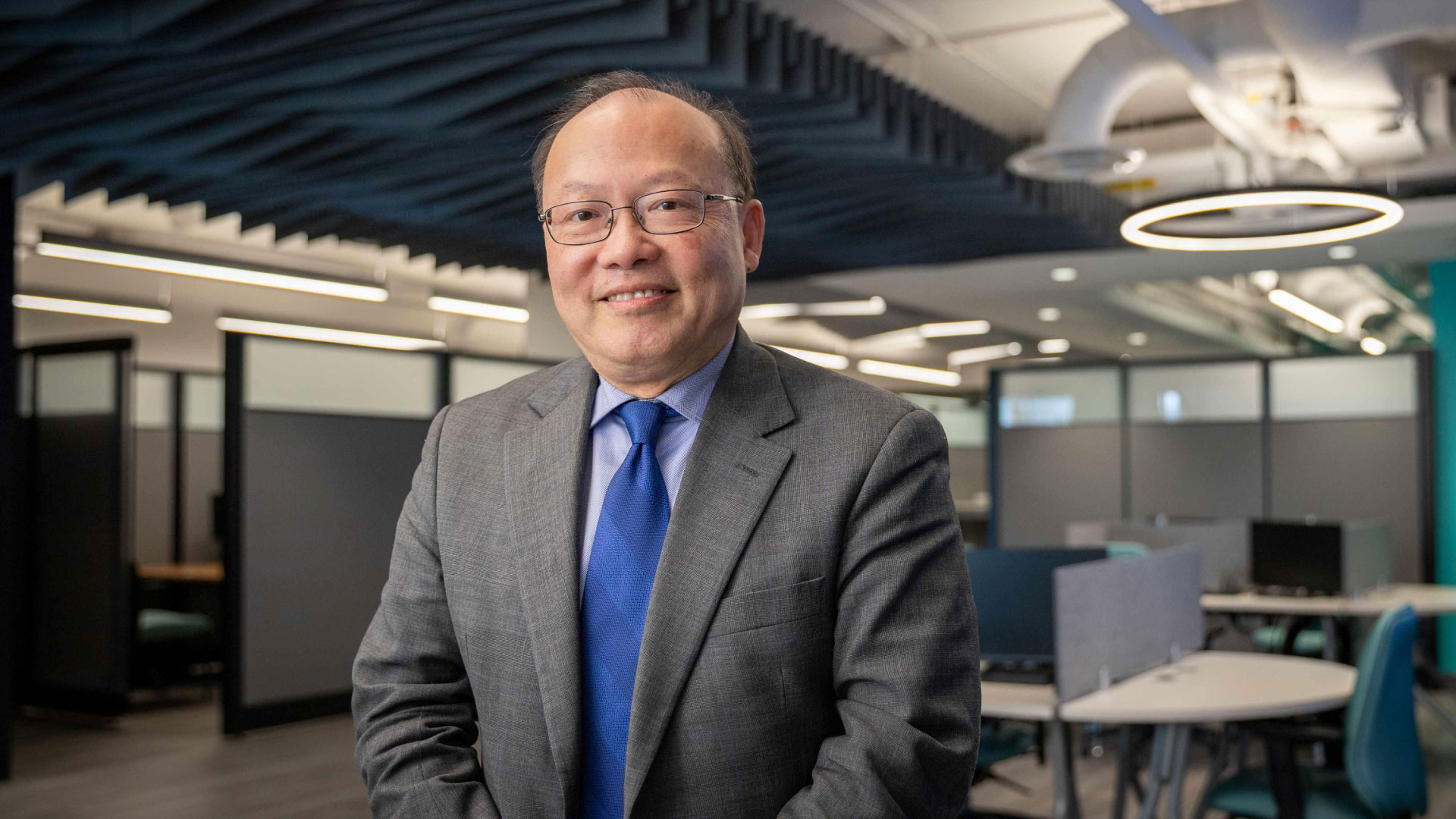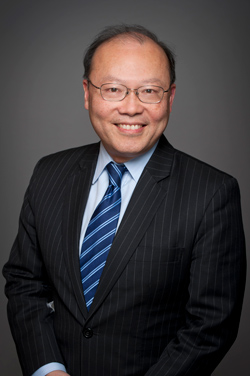
Dr. Peter Liu has spearheaded the research enterprise of the University of Ottawa Heart Institute (UOHI) since 2012.
In July, he will complete his term and pass on the podium from which he delivered countless scientific presentations, conferences, meetings and beloved research events, to welcome his successor, Dr. Katey Rayner, the institute’s next chief scientific officer and vice-president of research.
Handpicked by Dr. Wilbert J. Keon for his scientific contributions and leadership at the Institute of Circulatory and Respiratory Health of the Canadian Institutes of Health Research (CIHR), Dr. Peter Liu is chiefly responsible for uniting the Heart Institute’s research division on the hallmarks of teamwork and team spirit. In fostering collaboration amongst researchers within our walls and across borders and even oceans, he has transformed the UOHI’s research division into a global force for scientific discovery and knowledge translation.

Dr. Liu is world-renowned for his work to improve our understanding of heart failure and cardiac inflammation. He discovered how viruses can enter the muscle tissue of the heart and trigger a process called inflammation. His discoveries have had a global impact in shaping our understanding of COVID-19 on the cardiovascular system.
Recently, we sat down for a chat with Dr. Peter Liu. What follows is a summary of that conversation.
The Beat: What motivated you to pursue a career in cardiovascular research?
Dr. Peter Liu: It started in my first year of medical school. I was looking for a summer job. I was interested in studying the immune system. As it turned out, people were telling me the Heart & Stroke Foundation had a summer scholarship program that allowed you to do research. The chief of cardiac surgery at the Toronto Western Hospital – Dr. Ronald Baird – was looking for a motivated student. So, it was a bit of accidental luck. I also checked with my mother, and she said that heart disease is really important.
How did your career at the Heart Institute begin?
Prior to coming to the Heart Institute, I was the scientific director of the Institute of Circulatory and Respiratory Health at the CIHR. I spent half my time in Ottawa and the other half in Toronto. I also participated as a scientific director of the Canadian Heart Health Strategy with the federal government. Senator Wilbert Keon was then the chair of the standing committee on social affairs, science and technology, and its subcommittee on population health. We worked closely together on multiple projects and strategies. When I finished my term at CIHR, he wanted to keep me in Ottawa. He asked me to come work at the Heart Institute to help lead the research enterprise. Working with the team and then CEO Dr. Robert Roberts, we launched a new research strategy and recruited new talents. It has all been most rewarding.
What do you remember about those early days, and what has changed in the years since?
I remember I used to host a lot of brainstorming sessions at my home, and people really enjoyed it. We created these research clusters, and people organized and started putting projects and grants together. We were becoming more and more successful in terms of getting funding at the highest level. We have also recruited talented people from the world over. We partnered with different faculties at the University of Ottawa. We have increased peer-reviewed funding by five times in the past decade, which is a huge achievement. Publications have also increased in number and impact, with invited international lectures for our investigators. We worked as a team, and it took much sweat by so many to succeed in research.
Can you share a challenge you had to overcome during your tenure and the lesson you learned from that experience?
During the peak of the pandemic, we had to shut down a lot of our research labs and halt clinical studies. People had to work from home. Trying to conduct research over Zoom or MS Teams is a huge challenge. We had a lot of investigators with young families, with kids exposed in schools or trying to get vaccines. It was important for me to make sure that our teams were okay. I touched base regularly with our team, and I learned their personal struggles and triumphs. I was so moved by their dedication and commitment, and how lucky we are.
Can you discuss any significant advancements or innovations realized during your tenure as CSO and VP of research?
There is a long list!
I can think of Dr. Ruth McPherson’s pioneering work on cardiovascular genetics. Her discovery launched a new era in cardiovascular research. Now we call it precision medicine. Our most recent initiatives in this area are already helping to deliver the right treatments at the right time to the right patient.
Another key advance has been innovations in heart imaging. Dr. Rob Beanlands and Dr. Rob DeKemp have been most influential in advancing the technology and applications of imaging for our patients. We grew the Heart Institute’s PET [positron emission tomography] enterprise with major federal infrastructure funding, and we recruited superstars like Dr. Benjamin Rotstein, a radiochemist from Harvard University, and Dr. Adam Shuhendler, a researcher from Stanford, to spearhead our innovation agenda.
We’ve also made a lot of headway in recent years to improve valve surgery with new technologies and programs. We are building teams and hubs to link fundamental research with clinical applications. We have also conducted landmark clinical trials that changed how we care for patients at the bedside and influenced guidelines around the world.
This moment reminds me of this old Chinese proverb that says, “Drink water today, but think of its source.” The research we do today drives our clinical excellence tomorrow.
The other interesting phenomenon is what we call “the honey pot” effect. When you bring the best people together, and when you have the best infrastructure, you in turn attract the best talent. Whether we recruit them to join our team at the Heart Institute, or we collaborate regionally, nationally, or internationally. We also continue to attract the best trainees to come to study at the Heart Institute.
How important has teamwork and collaboration been for you, and what impact have they had on the research output here at the Heart Institute?
Collaboration and partnership are the true enablers of research impact.
For example, during the pandemic, we started to realize some patients were experiencing cardiovascular complications linked to the virus. We quickly assembled a team to better understand the underlying mechanisms that were driving this. We worked with epidemiologists, big data, and basic scientists. We built a team that was recognized by the chief science advisor of Canada, Dr. Mona Nemer, as leading edge. She then convened an expert panel in which we were able to contribute to the global understanding of how the infection affects the cardiovascular system. We were then able to work with the Public Health Agency of Canada to develop a cross-Canada registry. It has resulted in a whole set of collaborations and initiatives that have influenced how we manage these conditions today.
When I came to the Heart Institute, we were more isolated in our work. But then we realized that increased collaboration with the University of Ottawa, led by Dr. Sylvain Charbonneau (vice-president of research and innovation) and its Faculty of Medicine, led by Dean Dr. Bernard Jasmin and Vice-Dean Dr. Jocelyn Côté and others, was critical. We broke down those barriers. We now have amazing joint recruits with the Heart Institute and the University of Ottawa’s Faculty of Medicine, Faculty of Science and the Telfer School of Management, amongst others. Some of these talents are just superstars in research! I think of Dr. Christopher Sun, Dr. Erin Mulvihill, Dr. Kyoung-Han Kim, Dr. Mireille Ouimet and Dr. Wenbin Liang as just some of the examples.
It’s about bringing some of the best minds together. This is the path that inspired our work in brain-heart research. Collaboration enriched our research. That’s what helped us to secure a $109-million-dollar program investment from the Canada First Research Excellence Fund – one of only two dedicated to health research in Canada.
As the departing CSO, what advice would you give to your successor in terms of managing research at the Heart Institute?
We’ve been building a strong foundation at the Heart Institute to enable our future success. Everything we do today has a strong purpose for tomorrow. It is always good to have new perspectives and new approaches to solving problems. This is where the collaborative, multi-perspective strategy can help to accelerate innovation. I think the key is during these moments of transition, we must step back and ask ourselves, ‘How can we reach the next level of excellence?’ Research is exciting, but it is a competitive enterprise. Having a good strategy is always important. Dr. Rayner is very skilled in terms of developing these visionary opportunities, and she will approach it from a different angle and perspective that is all her own, which is excellent. She will lead the Heart Institute to the next level.
Are there any specific skills or areas of research that you feel the institute should prioritize in the future?
To use a metaphor, the heart is in the ‘heart’ of the body’s system. It’s in the ‘heart’ of the biological system. If you think about it, our heart is at the ‘heart’ of our health. The heart talks with so many other systems: the brain, the lungs, the kidneys, for example. The heart enables other organs to function effectively. At the same time, the heart also takes cues from these organs and participates in health and disease. We need to think of the heart as more than just a pumping organ. The heart is at the ‘heart’ of our body’s health.
It's important for us to treat the diseases of today, but also to prevent the diseases of tomorrow. It’s about using the tools to advance our understanding of the disease process so that people can effectively change their life’s trajectory to maintain their health and enjoy life without worrying about a heart attack or a stroke.
Never miss a Beat
Want interesting stories like this delivered straight to your inbox as they happen? Subscribe to our mailing list.

